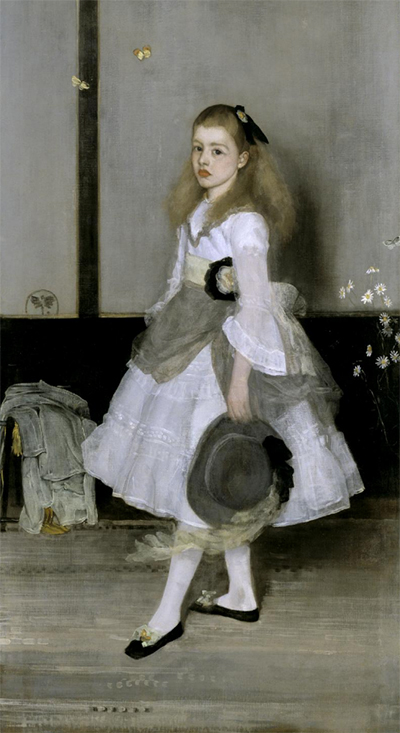Harmony in Grey and Green Miss Cicely Alexander was executed by the American artist James Abbott McNeill Whistler in 1872–4.
Cicely Alexander, the daughter of a successful London banker W.C. Alexander's, was 8 years old when James painted this portrait. Cicely might have been introduced to the artist through their common interest on Oriental art since Cicely had a collection of blue and white china and Japanese lacquer work. James added to this portrait a touch of Japonisme through a gold-edged black dado plus wall divider, as well as the butterflies and delicate daisies.
As the title proposes, the painting is harmony in green and grey. Cicely is standing on a grey matting, wearing a grey-toned dress and posing against a grey wall. The pale green of that long feather seen in the hat she is wearing is picked up in her black pumps bows plus the sash of the dress she is wearing. Having controlled the colouring of the subject so accurately, the artist was determined to make sure it matches with his paints and asked more than 70 sittings from Cicely, each lasting several hours.
Also, James painted Agnes Mary, Cicely's older sister, and was planning to paint her first; however, the artist was instead inspired to paint the young girl wearing a dress and Manet's Lola de Valence pose (1862, Musée d'Orsay). James gave strict instructions on how Cicely should be dressed, designing the dress she wore in detail and giving directions where to find perfect fine Indian muslin material. Walter Greaves, the artist's sister, was made to order the beautiful black and white carpet Cicely is standing on.
One of the most enthralling aspects of this painting is the austere design joining with the valuable colouring to create a very delicate sense of brittle beauty. Along with James' success in balancing as well as picking out delicate shades of curves, textures and colour, the feather is seen in the hat, for example, and the lines, the artist captured the kid's hesitation at being made actually to pose in that way, plus her rather accusatory look, is natural and different from what is seen in formal portraiture. The finished work pays tribute to Manet, and through its tonal handling of paint and loose brushwork, it draws on Velazquez work, who had portrayed Spanish court members in the same colouring and poses.




